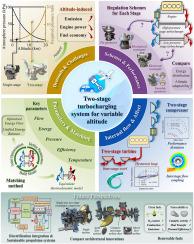可变高度应用的活塞发动机能量利用:两级涡轮增压技术综述
IF 16.3
1区 工程技术
Q1 ENERGY & FUELS
引用次数: 0
摘要
面对高海拔地区的环境挑战和发展压力,航空和地面交通都迫切需要可持续的发动机解决方案。高度引起的空气密度降低导致每公里高度8 - 13%的功率损失和活塞式发动机显著的排放恶化,这些问题需要有效的技术解决方案。本系统综述研究了在高海拔环境下运行的两级涡轮增压系统,重点关注从中等到近空间海拔的航空应用以及山区的地面运输。本文系统分析了各种涡轮增压配置、关键参数、匹配方法和级间流动现象,建立了高度自适应两级涡轮增压的综合框架。这些系统在控制灵活性、高度适应性、燃油经济性和排放控制方面具有显著优势,优化配置可在5.5公里高度实现高达95%的海平面功率恢复,并使无人机能够在压力比超过23的情况下达到20公里。与单级替代方案相比,这些优势提供了卓越的性能,但同时也带来了实现方面的挑战,包括系统成本、重量和封装复杂性的增加。通过综合之前在系统配置、参数优化和流动动力学方面的零散研究,这项工作为可持续的高空发动机系统提供了理论基础和实际设计指导。未来的发展路径包括紧凑型架构、电气化集成、可再生燃料和先进的推进系统,旨在解决具有挑战性的海拔剖面的性能和环境要求。这项工作填补了高空发动机技术的关键知识空白,并支持环境敏感的山地环境中的可持续交通发展。本文章由计算机程序翻译,如有差异,请以英文原文为准。

Piston engine energy utilization for variable-altitude applications: A review of two-stage turbocharging technologies
Amid environmental challenges and development pressures in high-altitude regions, sustainable engine solutions are urgently needed for both aviation and ground transportation. Altitude-induced air density reduction causes 8–13 % power loss per km of altitude and significant emissions deterioration in piston engines—problems that demand effective technical solutions. This systematic review examines two-stage turbocharging systems operating in high-altitude environments, focusing on aviation applications from moderate to near-space elevations and ground transportation in mountainous regions. The review systematically analyzes various turbocharging configurations, key parameters, matching methods, and inter-stage flow phenomena to establish a comprehensive framework for altitude-adaptive two-stage turbocharging. These systems provide notable advantages in control flexibility, altitude adaptability, and improvements in fuel economy and emission control, with optimized configurations achieving up to 95 % sea-level power restoration at 5.5 km altitude and enabling unmanned aerial vehicles to reach 20 km with pressure ratios exceeding 23. While delivering superior performance compared to single-stage alternatives, these gains come with implementation challenges including increased system cost, weight, and packaging complexity. By synthesizing previously fragmented research across system configurations, parameter optimization, and flow dynamics, this work provides both theoretical foundations and practical design guidance for sustainable high-altitude engine systems. Future development pathways include compact architectures, electrification integration, renewable fuels, and advanced propulsion systems aimed at addressing performance and environmental demands across challenging altitude profiles. This work fills critical knowledge gaps in high-altitude engine technology and supports sustainable transportation development in environmentally sensitive mountain environments.
求助全文
通过发布文献求助,成功后即可免费获取论文全文。
去求助
来源期刊

Renewable and Sustainable Energy Reviews
工程技术-能源与燃料
CiteScore
31.20
自引率
5.70%
发文量
1055
审稿时长
62 days
期刊介绍:
The mission of Renewable and Sustainable Energy Reviews is to disseminate the most compelling and pertinent critical insights in renewable and sustainable energy, fostering collaboration among the research community, private sector, and policy and decision makers. The journal aims to exchange challenges, solutions, innovative concepts, and technologies, contributing to sustainable development, the transition to a low-carbon future, and the attainment of emissions targets outlined by the United Nations Framework Convention on Climate Change.
Renewable and Sustainable Energy Reviews publishes a diverse range of content, including review papers, original research, case studies, and analyses of new technologies, all featuring a substantial review component such as critique, comparison, or analysis. Introducing a distinctive paper type, Expert Insights, the journal presents commissioned mini-reviews authored by field leaders, addressing topics of significant interest. Case studies undergo consideration only if they showcase the work's applicability to other regions or contribute valuable insights to the broader field of renewable and sustainable energy. Notably, a bibliographic or literature review lacking critical analysis is deemed unsuitable for publication.
 求助内容:
求助内容: 应助结果提醒方式:
应助结果提醒方式:


